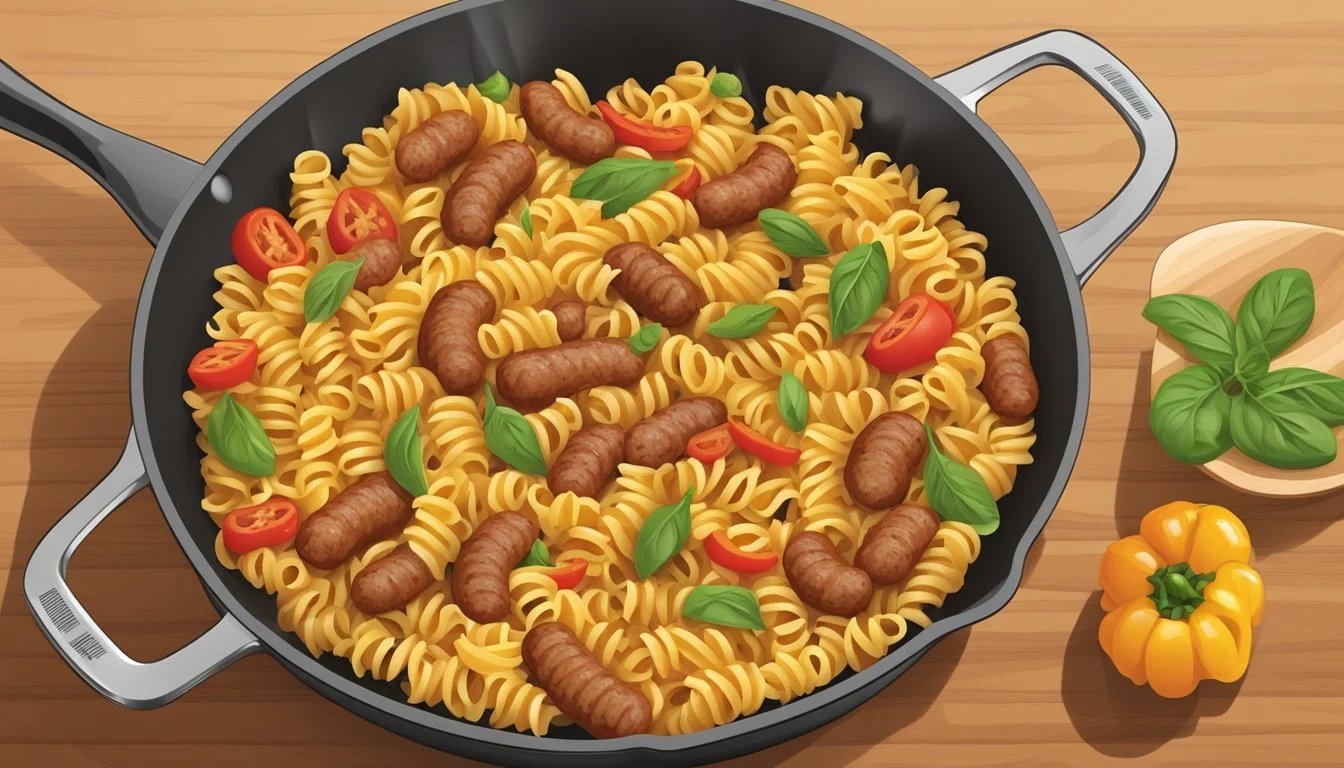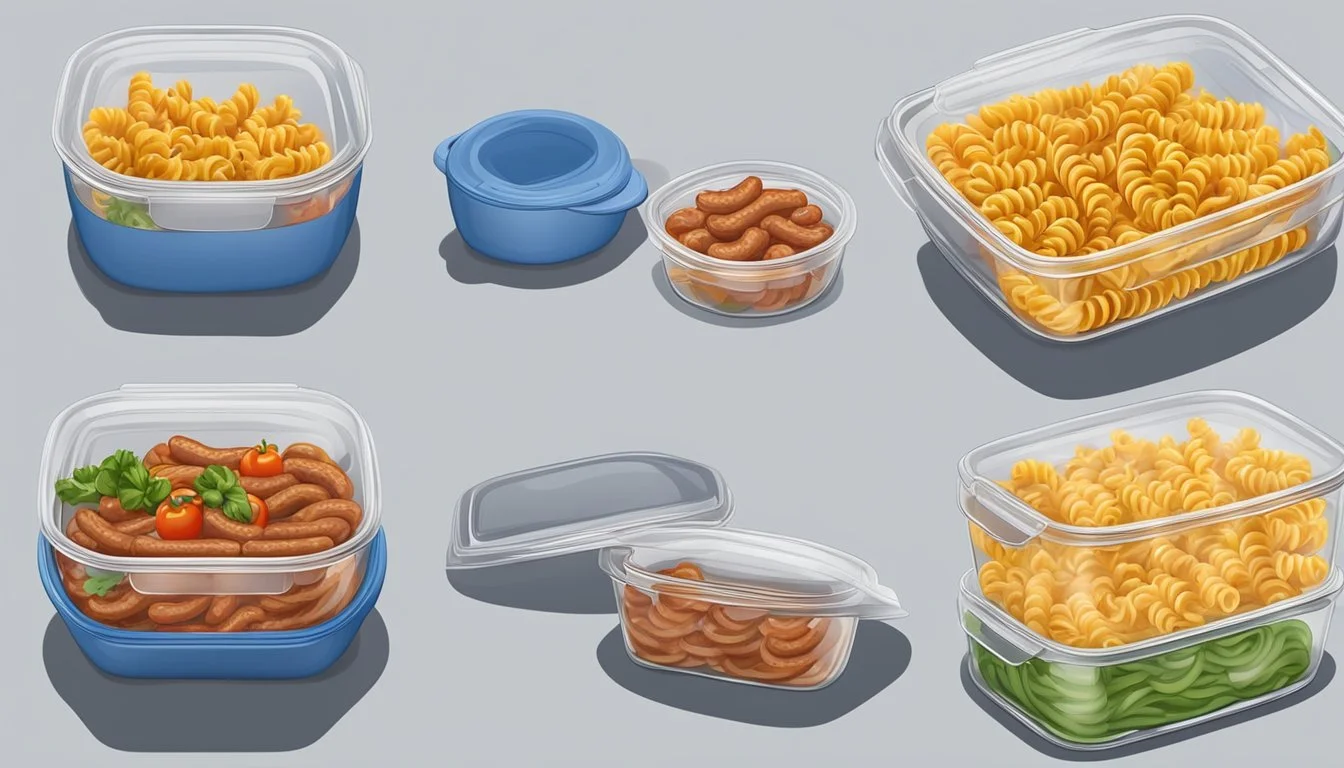Best Way to Reheat Fusilli with Sausage and Peppers
Ensuring Al Dente Pasta and Rich Flavors
Reheating fusilli with sausage and peppers while maintaining the pasta's (What wine goes well with pasta?) al dente texture and the sausage's rich flavor can be challenging. Pasta, particularly fusilli with its spiral shape, is prone to becoming soft and overcooked, while sausage and peppers may lose their vibrant taste and crisp texture if not reheated properly. Proper reheating technique ensures that each element of the dish retains its intended quality, resulting in a meal that tastes freshly made.
Key to the reheating process is gentle and even heat application. Microwaves can often reheat quickly but may result in unevenly heated food, with the pasta becoming too soft. Ovens, on the other hand, provide a consistent heat that warms the dish thoroughly without the risk of making the pasta mushy. The oven method also preserves the sausage's flavor profile, which is essential for the overall balance of the dish. Covering the dish can trap moisture, preventing the ingredients from drying out, and periodic stirring of the pasta can further assist in even heat distribution.
Assessing Leftover Sausage and Fusilli Quality
When it comes to reheating leftover fusilli with sausage and peppers, the key is to first evaluate the quality of the leftovers. Proper storage is crucial for maintaining the safety and quality of the dish. One must check for spoilage and assess the condition of the sausage and pasta to ensure a successful reheating that preserves the dish's flavor and texture.
Checking for Spoilage
One must first identify any signs of spoilage to ensure the leftover fusilli with sausage and peppers is safe to consume. Leftovers should have been stored in the refrigerator within two hours of cooking to minimize the risk of harmful bacteria growth.
Visual Inspection:
Look for any mold or discoloration on the sausage, pasta, or peppers.
Check for any unusual changes in the appearance of the sauce, which might indicate spoilage.
Olfactory Assessment:
Smell the dish. An off-odor could suggest the growth of harmful bacteria or that the dish has gone bad.
Determining Sausage and Pasta Condition
After ensuring the leftovers are safe to eat, one should check the texture and moisture of the sausage and fusilli.
Sausage Texture:
The sausage should be firm yet still have some give when pressed. If it feels overly slimy or dried out, it may not reheat well.
Pasta Texture:
Fusilli pasta should retain its shape and be al dente to the touch. Pasta that is too hard may have dried out, and if it's mushy, it may have absorbed excess moisture.
Moisture Content:
Leftover sausages should still contain some moisture for optimal flavor upon reheating.
Check the pasta dish as a whole for an even distribution of sauce, as this helps maintain moisture and quality when reheating leftovers.
Preparing for Reheating
Before reheating fusilli with sausage and peppers, ensuring the dish will retain its quality is paramount. The texture of the pasta and the flavor of the sausage are best preserved by following a preparatory process that begins with bringing the dish to room temperature and setting up an appropriate reheating station.
Bringing to Room Temperature
It's crucial for the fusilli with sausage and peppers to be brought to room temperature before reheating. This step encourages even warming and helps to prevent the pasta from becoming too soft when it's reheated. To achieve this, one should remove the dish from the refrigerator approximately 30 minutes before the reheating process begins.
Setting Up Reheating Station
To facilitate the optimal reheating of fusilli with sausage and peppers:
Oven Method:
Preheat the oven to 350°F (175°C).
Utilize an oven-safe dish and cover it with foil to maintain moisture.
Microwave Method:
Arrange the food in a microwave-safe dish, ensuring there's space for the pasta to spread out slightly.
Cover loosely to allow steam to escape, which helps keep the pasta al dente.
Reheating Methods Overview
Choosing the right reheating method is essential to retain the al dente texture of the fusilli and maintain the rich flavor of the sausage and peppers.
Oven Reheating
Oven reheating is ideal for preserving the dish's quality. Preheat the oven to 350°F and spread the fusilli with sausage and peppers on a baking tray. It's recommended to loosely cover the dish with aluminum foil to prevent drying out. Heat for 10-15 minutes, checking periodically.
Stovetop Techniques
When using the stove, opt for a frying pan or saucepan for evenly distributed heat. Reheat over a medium flame with a splash of water or sauce to keep the pasta moist. Continuously stir to evenly warm through and prevent sticking, typically for about 5 minutes.
Microwave Method
The microwave offers a quick reheating option. Place the fusilli in a microwave-safe dish, cover with a damp paper towel to retain moisture, and reheat in 30-second intervals, stirring in between to ensure even heating. This method may slightly soften the pasta beyond al dente.
Alternative Reheating Appliances
Air fryers can be used as an alternative reheating appliance. Set the air fryer to 350°F, place the dish inside for a few minutes, and use a baking tray if available to hold the pasta mixture. Monitor closely as the circulating hot air can crisp the ingredients and alter the texture.
Achieving Al Dente Fusilli and Flavorful Sausage
Reheating fusilli with sausage and peppers necessitates a careful approach to preserve the pasta's al dente texture and the sausage's robust flavor. The strategies discussed below aim to guarantee these attributes.
Ensuring Even Heating
Even heating is crucial to warm the dish thoroughly while preventing the sausage from becoming overcooked. The reader should consider the following steps:
Preheat: A skillet or pan should be preheated on medium heat before adding the pasta and sausage.
Stirring: Consistently stirring the ingredients helps distribute heat evenly, which is essential in reaching a uniform internal temperature.
Meat Thermometer: The internal temperature of the sausage should register between 165-175°F. Using a meat thermometer ensures the sausage is heated to a safe and flavorful state without drying out.
Maintaining Pasta Texture
A desirable al dente texture in fusilli is attainable with these practices:
Olive Oil: A small drizzle of olive oil tossed with the pasta can help prevent sticking and clumping, which aids in keeping the individual fusilli pieces separate and firm.
Pasta Sauce: Heating the pasta sauce separately and then combining it with the fusilli can help maintain the pasta's texture. One must be careful not to over-saturate the fusilli, as excess moisture can lead to a softer than desired texture.
Safety and Storage After Reheating
To maintain the quality and safety of fusilli with sausage and peppers after reheating, proper storage techniques are crucial, and precautions must be taken to prevent foodborne illness.
Proper Storage Techniques
Once fusilli with sausage and peppers is reheated, it should be stored safely to preserve its flavor and texture. If there are leftovers, they must be placed in an airtight container to prevent the pasta from turning soggy and to retain the sausage’s flavor. Any pasta dish, including this one, should be stored in the fridge within two hours of cooking to prevent bacterial growth. For longer storage, freezing sausages and pasta separately can be effective; however, pasta is best enjoyed when not frozen as it can lose its al dente texture.
Refrigerator storage: Store in airtight containers for 3-4 days.
Freezer storage: Although not recommended for this dish, freezing is possible. Freeze in covered airtight containers or heavy-duty freezer bags.
Preventing Foodborne Illness
Ensuring that the fusilli with sausage and peppers is piping hot, with an internal temperature of 165°F (74°C) when reheating, is essential in preventing food-related illnesses. It's crucial never to reheat the dish more than once. The proper reheating technique requires starting with a preheated oven or a stovetop to ensure even heating and maintaining the dish's integrity.
Reheating temperature: Heat to at least 165°F (74°C).
One-time reheating: Avoid reheating the meal more than once to prevent bacterial growth.
Final Touches and Serving Suggestions
After reheating fusilli with sausage and peppers to maintain the pasta's al dente texture and the meat's rich taste, a few final touches can enhance the dish before serving. The addition of complementary sides and a focus on enhancing sausage flavor ensure a satisfying eating experience.
Adding Complementary Sides
Salads: A simple green salad, dressed with a vinaigrette, works well to cut through the richness of the sausage and adds a fresh element to the plate.
Type Ingredients Dressing Caesar Romaine, Croutons, Parmesan Caesar Arugula Arugula, Pine nuts, Cherry tomatoes Balsamic
Bread: Serving warm, crusty bread, like a baguette or garlic bread, complements the pasta dish and can be useful for mopping up any leftover sauce.
Garlic Bread: Slice a baguette in half, butter generously, sprinkle with garlic, and toast until golden brown.
Baguette: Warm a whole baguette in the oven and serve it sliced, allowing guests to help themselves.
Enhancing Sausage Flavor
Condiments: To intensify the sausage flavor, consider serving with select condiments that can be added as per individual preference.
Barbecue Sauce: Offers a smoky and tangy taste that pairs well with hearty sausages.
Mustard: A strong mustard can add a pungent kick that complements the spices in the sausage.
Relish: A dollop of sweet or dill relish can add a refreshing contrast to the dish.
Eggs: For those who enjoy brunch, topping the reheated fusilli and sausage with a scrambled egg can add a creamy texture and rich flavor that binds the dish together.
To ensure the best taste, serve these options on the side, allowing guests to add as much or as little as they like, tailoring the flavor to their preference.
FAQs and Troubleshooting
In this section, readers will find solutions to common problems encountered when reheating fusilli with sausage and peppers and how to manage different types of sausage to preserve flavor and texture.
Common Reheating Issues
Problem: Pasta becomes too soft or mushy.
Solution: To prevent overcooking, reheat fusilli in a preheated oven at 350°F for about 10-15 minutes or use the microwave in short bursts, checking frequently.
Problem: Sausage dries out.
Solution: Keep the sausage moist by covering the dish with a lid or foil when reheating in the oven, or by adding a small amount of water or stock when reheating on the stove.
Uneven Heating: Rotate or stir the contents halfway through reheating to ensure even distribution of heat.
Adjustments for Different Sausage Types
The type of sausage can affect reheating methods and outcomes. Below are tailored instructions for pork and chicken sausages:
Pork Sausages (What wine goes well with pork sausages?) :
Steaming: An effective method that involves heating pork sausages without direct contact with water or oil, preserving their succulence.
Chicken Sausages:
Lower Temperature: Chicken sausages tend to dry out more easily, so reheat at a slightly lower temperature than pork, around 325°F.
Shorter Time: Monitor the time closely as chicken sausages typically require less time to reheat.





